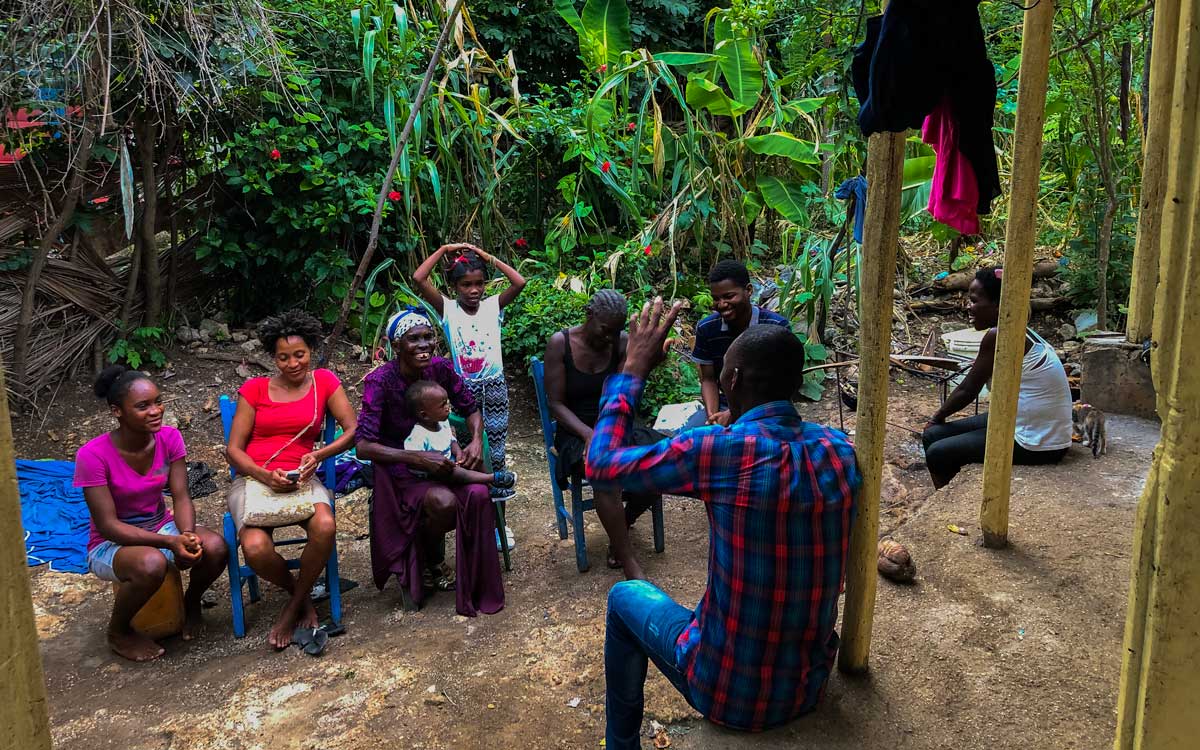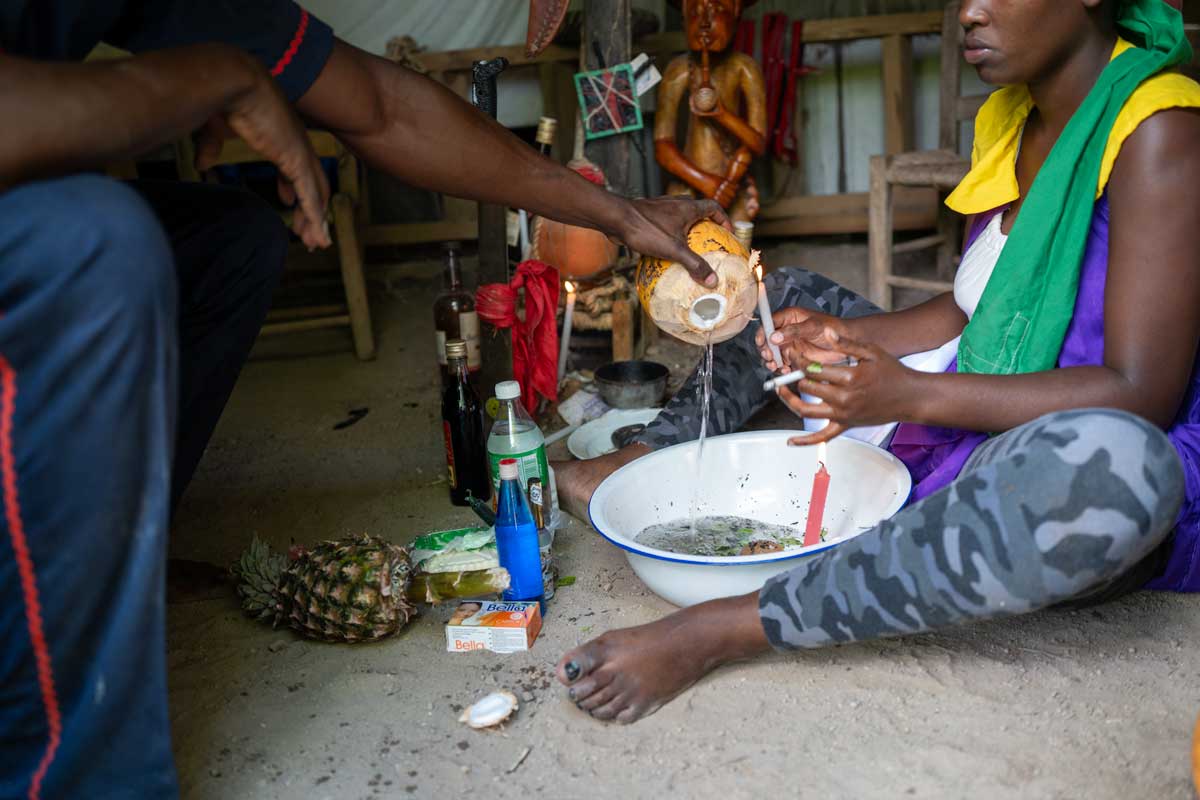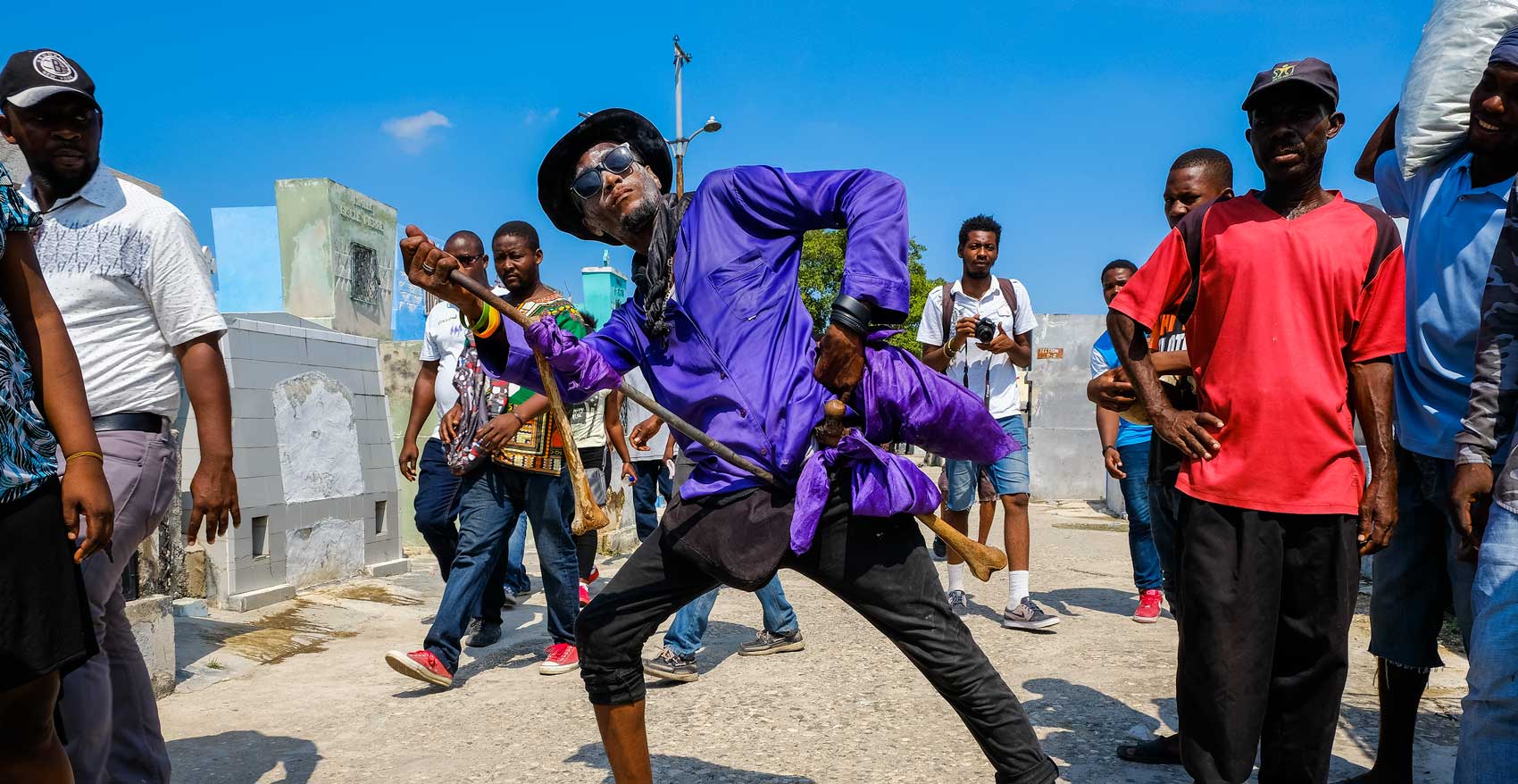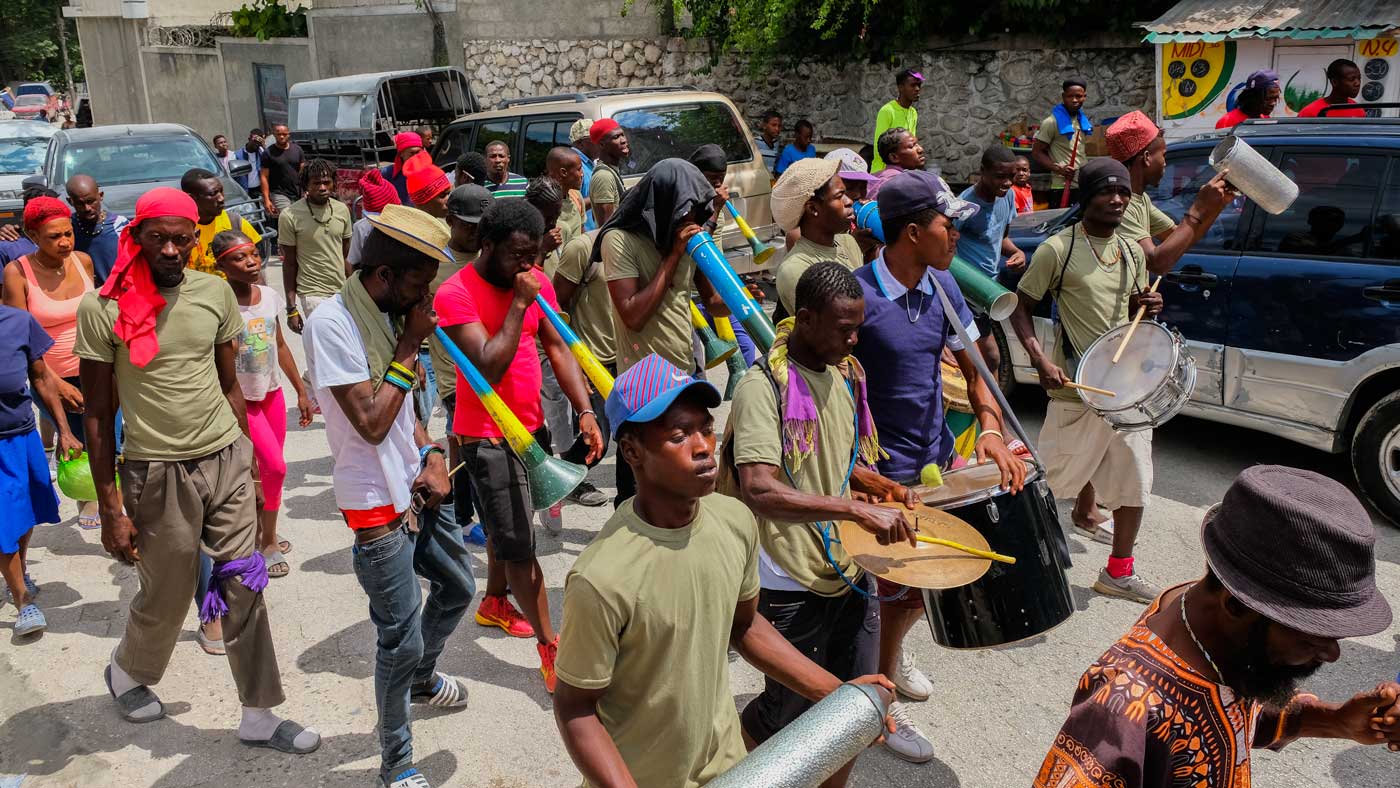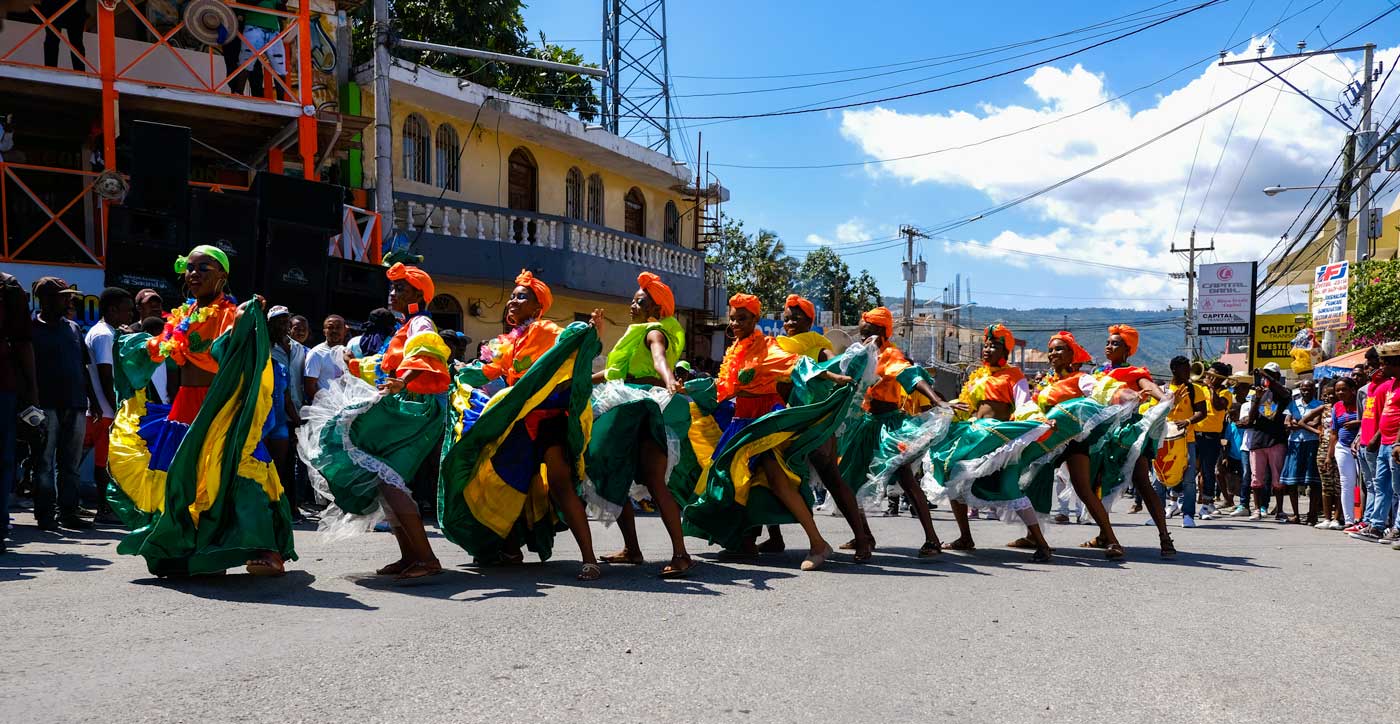
Photo: Jean Oscar Augustin
Lansèt Kòd – the Haitian Tradition You’ve Probably Never Heard Of
Uncover the Strange and Captivating Haitian Carnival Tradition of Lansèt Kòd
Embark on a journey of cultural discovery with the Haitian Carnival – where music, dance, and artistic expression come to life. Amidst the lively parades and colorful costumes, one tradition stands out as truly original and captivating – the Lansèt Kòd.
This century-old spectacle, where fearless participants cover themselves in black paint and run around in the streets, is a sight you won’t soon forget. But be warned, the Lansèt Kòd may seem strange or even intimidating to the unassuming observer, although for those who dare to experience it, it’s a true exhibition of Haitian culture.
To delve deeper into the Haitian tradition of the Lansèt Kòd, we traveled to Jacmel, the hub of cultural heritage in Haiti’s southeast department, to witness the preparation of the disguise, the pulsating energy, and the spectacle of the procession that culminates at sunset.
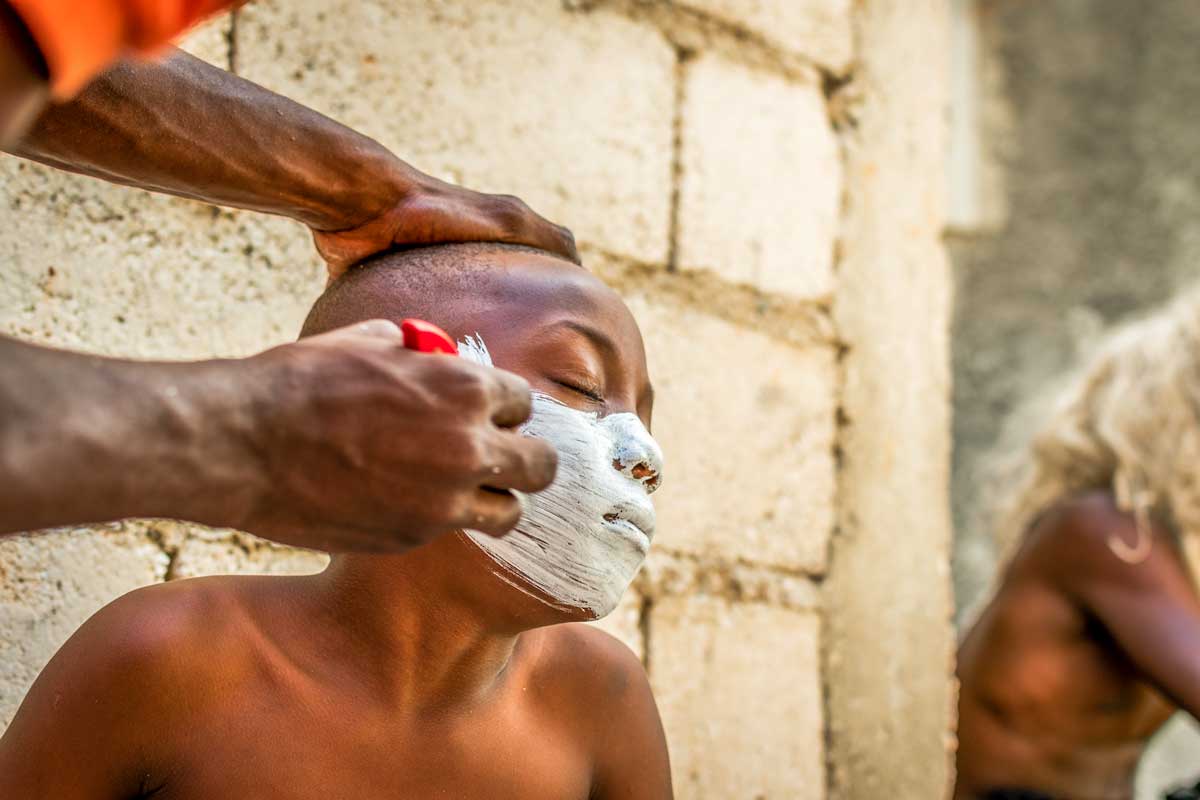
Photo: Jean Oscar Augustin
Embracing Eccentricity: A Behind-the-Scenes Look
On a Sunday morning during carnival season in Jacmel, the sleepy coastal town is gradually stirring as the sun rises. The air is salty from the nearby ocean and the sky is a brilliant blue. In a neighborhood lakou, a group of young men gathers, ready to disguise themselves for their weekly outing. They move to the beat of méringue music blaring from a cell phone, as they arrange their costumes, made from cut-out pants and ragged shorts.

Photo: Jean Oscar Augustin
Papier-mâché horns, painted fresh, dry in the sun as motorcycles drive by, adding to the noise of the street. To complete their look, some of the participants hold long whips, ready to snap as they parade through the town. Eccentricity is encouraged and embraced in these groups, with some sporting miniskirts and wigs in varying shades of brown, blonde and multicolored.
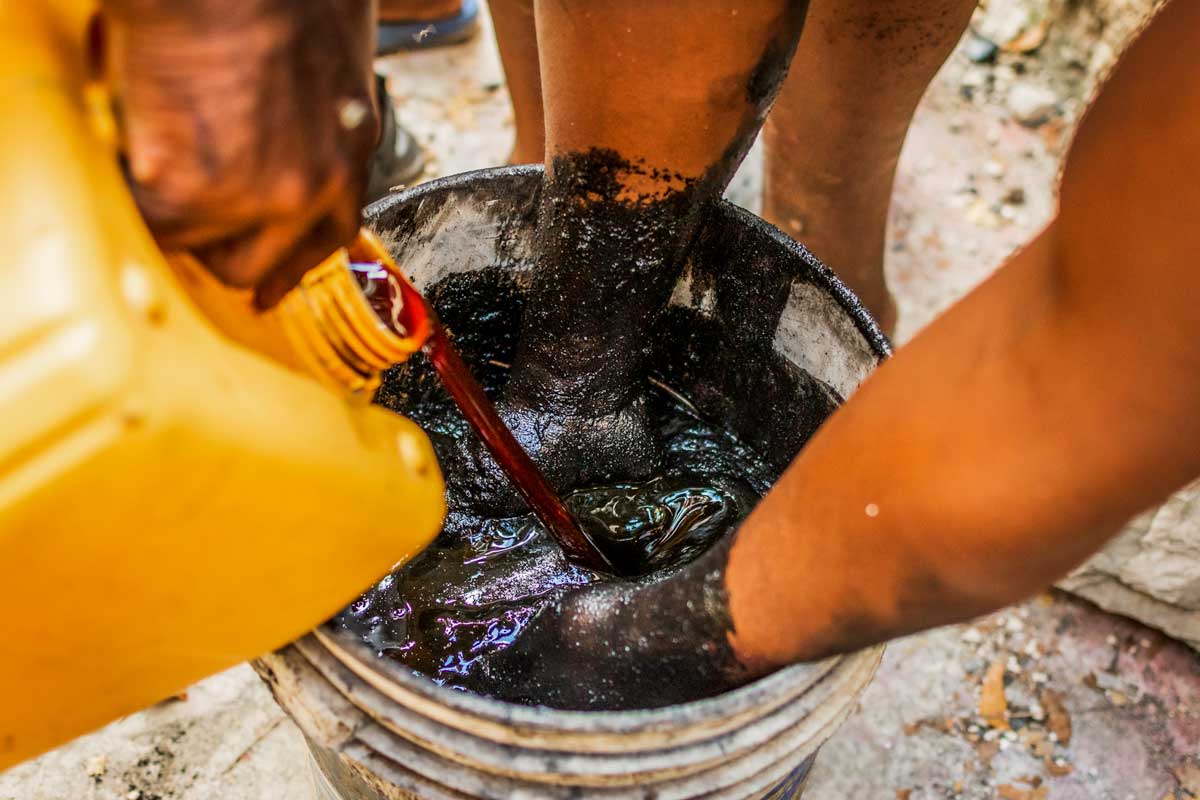
Photo: Jean Oscar Augustin
In a corner of the courtyard, the leader prepares the central element of their disguise – a mixture of charcoal powder and cane syrup. The result is a thick, shiny black substance. The air is filled with a sweet, sugary aroma as the young men cover themselves head-to-toe with the mixture, only leaving ragged shirts, wigs, horns, and whips as the only other visible clothing.
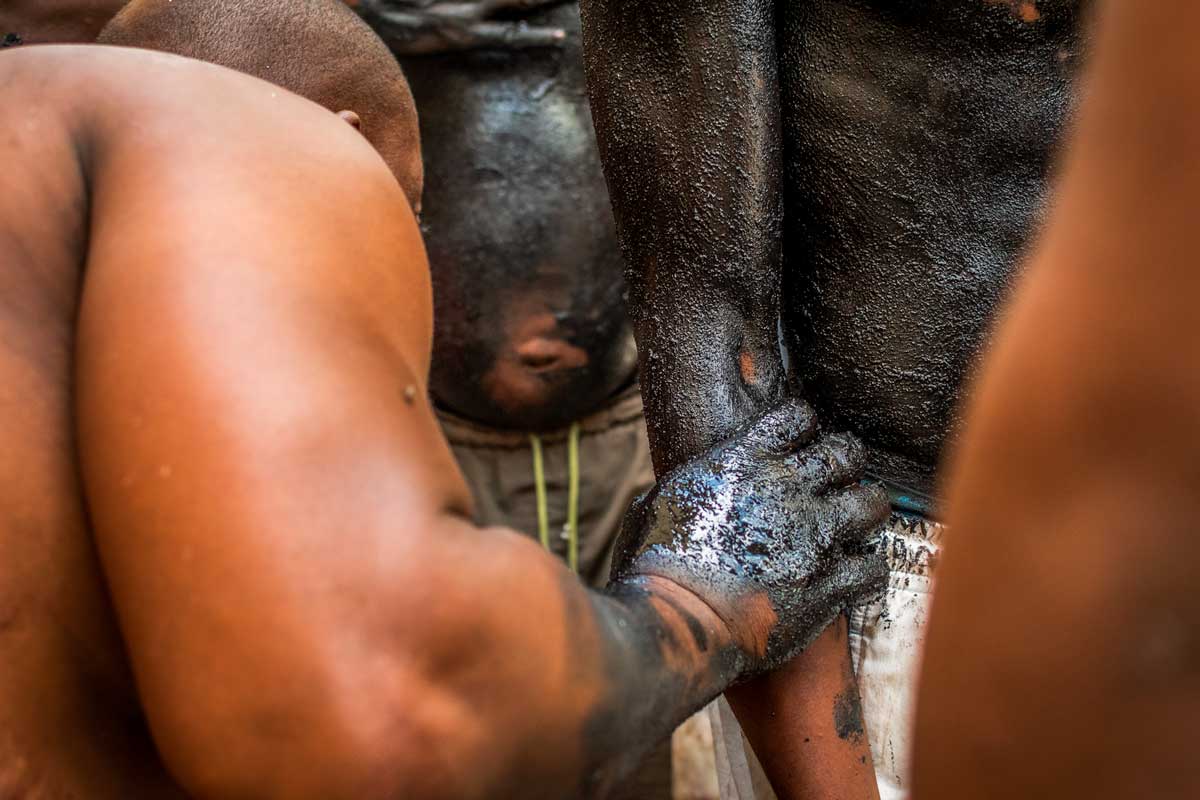
Photo: Jean Oscar Augustin
Friends help each other apply the black paint, leaving their skin sticky and oily. Finally, with their disguises complete, the Lansèt Kòd are ready to take the streets of Jacmel by storm.

Photo: Jean Oscar Augustin
The Origin of Lansèt Kòd: A Look into Its History
The Haitian tradition of Lansèt Kòd, (rope throwers in English or lanceurs de cordes in French), is rooted in the history of the French colony of Saint Domingue (present-day Haiti). During the colonial period, European-style carnivals were held in Saint Domingue, featuring lavish costumes and festivities.
Enslaved people, who were banned from participating in these carnivals, would stage their own mini-carnivals in their backyards, dress in tattered clothing and carry whips, with their skin smudged in a mix of grease and ashes they imitated and mocked their masters’ behavior.
This tradition was originally created as a form of ridicule of the slave masters, who would attend carnivals dressed in their finery. However, after Haiti gained independence, the newly freed people adopted the European Carnival tradition and infused it with their own music and culture.
Today, the Lansèt Kòd tradition is a celebration of Haitian culture and independence. In the collective imagination of Haitians, the Lansèt Kòd have also evolved into a symbol of good behavior for children, a kind of bogeyman that is used to encourage kids to be well-behaved.

Photo: Jean Oscar Augustin
The Mark of the Black Hand
As the Lansèt Kòd group leave the lakou and venture out into the streets, they bring with them a sense of dezod (meaning chaos and disorder in Haitian Creole) Their black-painted bodies are a stark contrast against the brightly colored houses of Jacmel. With synchronized stomping and singing, they draw the attention of everyone around them. In the center of the group, a member carries a flagpole waving their banner proudly.
And suddenly, they all break into a sprint.

Photo: Jean Oscar Augustin
In a seemingly choreographed manner they split into smaller groups, running through the narrow city streets while playfully trying to touch others with their black-painted hands. The hunting party has begun.
As the Lansèt Kòd start chasing after unsuspecting bystanders they leave their mark in the form of a black handprint. This may come across as strange or even frightening, but it’s all in good fun and part of the tradition. In fact, the majority of people who receive the “blessing” of the black paint are friends of the Lansèt Kòd entourage.

Photo: Jean Oscar Augustin
However, there’s one thing you should keep in mind: the Lansèt Kòd have a particular fondness for white clothing. If you’re wearing your finest dress or favorite white shirt, be prepared to end up with a black handprint on your back.
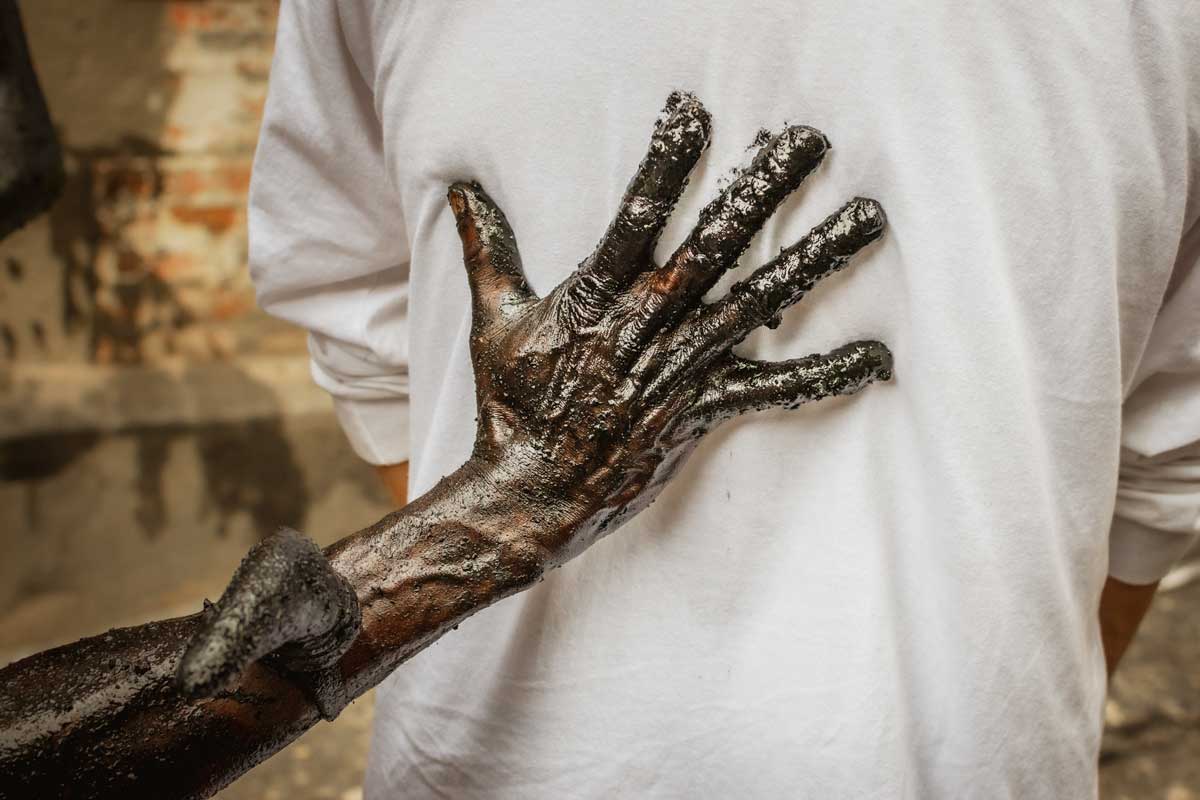
Photo: Jean Oscar Augustin
The black marks left by the Lansèt Kòd have a deeper meaning, as they evoke the Haitian proverb “Pito nou lèd, nou la,” meaning “We may be ugly, but we are still here.” This powerful statement is connected to the brutal system of slavery and symbolizes the idea that being free and alive, even if it means being “ugly,” is preferable to being subjugated under French rule.
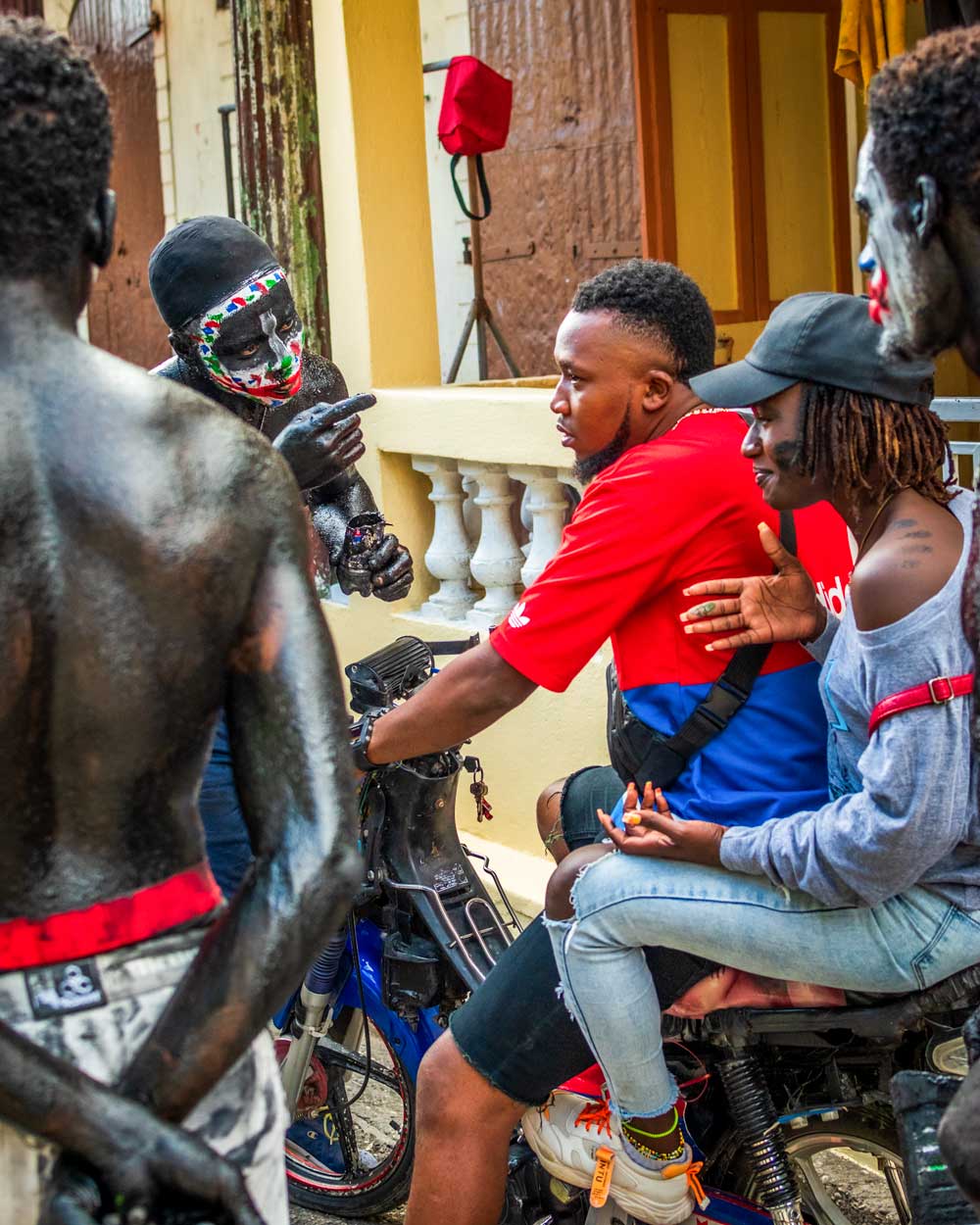
Photo: Jean Oscar Augustin
A Shared Caribbean Tradition
The Haitian cultural tradition of Lansèt Kòd in can be found in different forms throughout the Caribbean. At Trinidad’s Carnival, participants of Jouvert (French for daybreak) cover their bodies in a variety of substances, including oil and body paint, to party in the streets. Jouvert celebrates a rebellious spirit, contrasting the allure of glitter, color, and feathers that dominate the mainstream carnival.
In Grenada, groups known as Jab-Jab participate in the annual Carnival. The name comes from the French word “Diable,” and Jab-Jab is essentially a giant street party with participants covering themselves in oil, mud, or grease and wearing cattle horns to embody the Jab-Molassie or “molasses devil”.
These traditions have roots in the pre-Lent festivities of former French colonies, where the wealthy class would don elaborate costumes and dance to orchestral music. Meanwhile, ex-slaves, with limited resources, would use ashes from burned cane, grease, and other materials to cover themselves in a satirical nod to slavery days. The music back then was created with the beating of biscuit tins, oil drums, and the blowing of conch shells. Today, these traditions have been preserved and continue to give the Caribbean region its vibrant and distinct character.

Photo: Jean Oscar Augustin
The Final Ritual
The Lansèt Kèd group keeps the energy high as they traverse the streets of Jacmel on this sunny January Sunday. They run through the winding roads, including Rue Seymour Pradel and the picturesque Rue du Commerce, home to historic gingerbread houses. The group stops traffic at street intersections, causing cars to honk and onlookers to either flee or gather for a closer view.

Photo: Franck Fontain
As the day goes on and the steep city streets are conquered, fatigue seems unlikely to set in. The group is invigorated by their shared excitement and a dose of Haitian moonshine, known as “kleren.”
While the sun dips below the horizon in the bay of Jacmel, the previously split-up groups converge at the ocean boardwalk in Lakou New York. Laughter and conversation fill the air as the members swap stories from their day. The atmosphere is one of joy and camaraderie.

Photo: Jean Oscar Augustin
Finally, at the signal from the leader, one member waves the group’s flag, a symbol of their bond and pride. And the rest of the group makes its way into the ocean for the final ritual of the day. The waves crash against their bodies, washing away the remnants of the black paint and any evidence of the day’s festivities. A ritualistic cleansing before the next Sunday’s performance.

Photo: Jean Oscar Augustin
Get in on the Action
Want to join the festivities and experience the unique Haitian tradition of Lansèt Kòd? You can do so by visiting Jacmel, Jérémie, Cap-Haïtien, Les Cayes or other major cities in Haiti during the carnival season. Jacmel is considered the best destination for its rich history and lively pre-carnival activities, with Lansèt Kòd groups starting their weekly performances from the first Sunday of January and continuing every Sunday until the Trois Jours Gras (the three fat days), where the main carnival parade takes place.
During the Trois Jours Gras, the rope throwers play a unique role in the main carnival parade. Not only do they represent the enslaved people of the colony of Saint Domingue, but they also help maintain order during the parade. In stark contrast to their usual image as chaos-makers they joyfully chase anyone who tries to disturb the parade.
So, if you’re thinking of disrupting the parade, be prepared to be pursued by the rope throwers. And, who knows, you might just end up being blackened.
For a more unique experience, consider joining a Lansèt Kòd for their Sunday performance. They welcome new participants and will gladly integrate you into this quirky, important symbolic tradition. To learn more, talk to your local friends, host, guide, or tour operator.
Written by Costaguinov Baptiste.
Published January 2023.
Explore Haiti’s Art & Culture

Paradise for your inbox
Your monthly ticket to Haiti awaits! Get first-hand travel tips, the latest news, and inspiring stories delivered straight to your inbox—no spam, just paradise.






